Evaluating Environmental Quality and Its Driving Force in Northeastern China Using the Remote Sensing Ecological Index
Abstract
:1. Introduction
2. Materials and Methods
2.1. Study Area
2.2. Data Sources and Preprocessing
2.3. Methods
2.3.1. Overall Technical Route
2.3.2. RSEI Index Construction
2.3.3. Trend Analysis Method
2.3.4. Driving Mechanism Analysis Method
3. Results
3.1. PCA Analysis Results
3.2. Annual Variations in the Eco-Environmental Quality in Northeastern China
3.3. Spatial-Temporal Evolution Characteristics of Ecological Environmental Quality in Northeastern China
3.3.1. Environmental Quality Grade Structure and Distribution
3.3.2. Analysis of Spatial-Temporal Changes in the Quality Grade
3.4. Influence Mechanism of the Ecological Environment Quality Changes in Northeast China
3.4.1. Single Factor Detection Analysis
3.4.2. Interaction Detection Analysis
4. Discussion
4.1. The Mechanism of Environmental Changes
4.2. Uncertainties
5. Conclusions
Author Contributions
Funding
Institutional Review Board Statement
Informed Consent Statement
Data Availability Statement
Acknowledgments
Conflicts of Interest
References
- Yao, X.; Chen, W.; Song, C.; Gao, S. Sustainability and efficiency of water-land-energy-food nexus based on emergy-ecological footprint and data envelopment analysis: Case of an important agriculture and ecological region in Northeast China. J. Clean. Prod. 2022, 379, 134854. [Google Scholar] [CrossRef]
- Crichton, K.A.; Anderson, K.; Charman, D.J.; Gallego-Sala, A. Seasonal climate drivers of peak NDVI in a series of Arctic peatlands. Sci. Total Environ. 2022, 838, 156419. [Google Scholar] [CrossRef] [PubMed]
- Vernet, M.; Ellingsen, I.; Marchese, C.; Bélanger, S.; Cape, M.; Slagstad, D.; Matrai, P.A. Spatial variability in rates of net primary production (NPP) and onset of the spring bloom in Greenland shelf waters. Prog. Oceanogr. 2021, 198, 102655. [Google Scholar] [CrossRef]
- Piao, S.; Wang, X.; Park, T.; Chen, C.; Lian, X.; He, Y.; Bjerke, J.W.; Chen, A.; Ciais, P.; Tømmervik, H.; et al. Characteristics, drivers and feedbacks of global greening. Nat. Rev. Earth Environ. 2020, 1, 14–27. [Google Scholar]
- Wu, J.; Wang, X.; Zhong, B.; Yang, A.; Jue, K.; Wu, J.; Zhang, L.; Xu, W.; Wu, S.; Zhang, N.; et al. Ecological environment assessment for Greater Mekong Subregion based on Pressure-State-Response framework by remote sensing. Ecol. Indic. 2020, 117, 106521. [Google Scholar] [CrossRef]
- Wu, C.; Liu, G.; Huang, C.; Liu, Q.; Guan, X. Ecological Vulnerability Assessment Based on Fuzzy Analytical Method and Analytic Hierarchy Process in Yellow River Delta. Int. J. Environ. Res. Public Health 2018, 15, 855. [Google Scholar] [CrossRef] [Green Version]
- Sun, L.; Yu, Y.; Gao, Y.; He, J.; Yu, X.; Malik, I.; Wistuba, M.; Yu, R. Remote Sensing Monitoring and Evaluation of the Temporal and Spatial Changes in the Eco-Environment of a Typical Arid Land of the Tarim Basin in Western China. Land 2021, 10, 868. [Google Scholar] [CrossRef]
- Xu, H. A remote sensing urban ecological index and its application. Shengtai Xuebao Acta Ecol. Sin. 2013, 33, 7853–7862. [Google Scholar]
- Nie, X.; Hu, Z.; Zhu, Q.; Ruan, M. Research on Temporal and Spatial Resolution and the Driving Forces of Ecological Environment Quality in Coal Mining Areas Considering Topographic Correction. Remote Sens. 2021, 13, 2815. [Google Scholar] [CrossRef]
- Xiong, Y.; Xu, W.; Lu, N.; Huang, S.; Wu, C.; Wang, L.; Dai, F.; Kou, W. Assessment of spatial–temporal changes of ecological environment quality based on RSEI and GEE: A case study in Erhai Lake Basin, Yunnan province, China. Ecol. Indic. 2021, 125, 107518. [Google Scholar] [CrossRef]
- Zhang, J.; Zhou, Q.; Cao, M.; Liu, H. Spatiotemporal Change of Eco-Environmental Quality in the Oasis City and Its Correlation with Urbanization Based on RSEI: A Case Study of Urumqi, China. Sustainability 2022, 14, 9227. [Google Scholar] [CrossRef]
- Firozjaei, M.K.; Kiavarz, M.; Homaee, M.; Arsanjani, J.J.; Alavipanah, S.K. A novel method to quantify urban surface ecological poorness zone: A case study of several European cities. Sci. Total Environ. 2021, 757, 143755. [Google Scholar] [CrossRef] [PubMed]
- Wang, B.; Tian, J.; Wang, S. Process and mechanism of transition in regional land use function guided by policy: A case study from Northeast China. Ecol. Indic. 2022, 144, 109527. [Google Scholar] [CrossRef]
- Yu, L.; Liu, T.; Bu, K.; Yan, F.; Yang, J.; Chang, L.; Zhang, S. Monitoring the long term vegetation phenology change in Northeast China from 1982 to 2015. Sci. Rep. 2017, 7, 14770. [Google Scholar] [CrossRef] [Green Version]
- Wang, H.; Yang, S.; Wang, Y.; Gu, Z.; Xiong, S.; Huang, X.; Sun, M.; Zhang, S.; Guo, L.; Cui, J.; et al. Rates and causes of black soil erosion in Northeast China. Catena 2022, 214, 106250. [Google Scholar] [CrossRef]
- Gorelick, N.; Hancher, M.; Dixon, M.; Ilyushchenko, S.; Thau, D.; Moore, R. Google Earth Engine: Planetary-scale geospatial analysis for everyone. Remote Sens. Environ. 2017, 202, 18–27. [Google Scholar] [CrossRef]
- Wu, H.; Fang, S.; Yang, Y.; Cheng, J. Changes in habitat quality of nature reserves in depopulating areas due to anthropogenic pressure: Evidence from Northeast China, 2000–2018. Ecol. Indic. 2022, 138, 108844. [Google Scholar] [CrossRef]
- Xu, H. Modification of normalised difference water index (NDWI) to enhance open water features in remotely sensed imagery. Int. J. Remote Sens. 2006, 27, 3025–3033. [Google Scholar] [CrossRef]
- Huang, S.; Tang, L.; Hupy, J.P.; Wang, Y.; Shao, G. A commentary review on the use of normalized difference vegetation index (NDVI) in the era of popular remote sensing. J. For. Res. 2021, 32, 2719. [Google Scholar] [CrossRef]
- Xu, N.; Deng, F.; Liu, B.; Li, C.; Fu, H.; Yang, H.; Zhang, J. Changes in the Urban Surface Thermal Environment of a Chinese Coastal City Revealed by Downscaling MODIS LST with Random Forest Algorithm. J. Meteorol. Res. 2021, 35, 759–774. [Google Scholar] [CrossRef]
- Hu, X.; Xu, H. A new remote sensing index for assessing the spatial heterogeneity in urban ecological quality: A case from Fuzhou City, China. Ecol. Indic. 2018, 89, 11–21. [Google Scholar] [CrossRef]
- Xu, H. A new index for delineating built-up land features in satellite imagery. Int. J. Remote Sens. 2008, 29, 4269–4276. [Google Scholar] [CrossRef]
- Jin, S.; Sader, S.A. Comparison of time series tasseled cap wetness and the normalized difference moisture index in detecting forest disturbances. Remote Sens. Environ. 2005, 94, 364–372. [Google Scholar] [CrossRef]
- Tang, H.; Fang, J.; Xie, R.; Ji, X.; Li, D.; Yuan, J. Impact of Land Cover Change on a Typical Mining Region and Its Ecological Environment Quality Evaluation Using Remote Sensing Based Ecological Index (RSEI). Sustainability 2022, 14, 12694. [Google Scholar] [CrossRef]
- Hu, Q.; Gong, E.; Wang, Z.; Zhang, J.; Liu, W.; Feng, F. Spatiotemporal Changes in Leaf Area and Carbon Sequestration of Terrestrial Vegetation in China over the Last Two Decades. Forests 2022, 13, 1623. [Google Scholar] [CrossRef]
- Hu, Z.; Liu, S.; Zhong, G.; Lin, H.; Zhou, Z. Modified Mann-Kendall trend test for hydrological time series under the scaling hypothesis and its application. Hydrol. Sci. J. 2020, 65, 2419–2438. [Google Scholar] [CrossRef]
- Wang, J.; Xu, C. Geodetector: Principle and prospective. Acta Geogr. Sin. 2017, 72, 116–134. [Google Scholar]
- Liu, C.; Li, W.; Zhu, G.; Zhou, H.; Yan, H.; Xue, P. Land Use/Land Cover Changes and Their Driving Factors in the Northeastern Tibetan Plateau Based on Geographical Detectors and Google Earth Engine: A Case Study in Gannan Prefecture. Remote Sens. 2020, 12, 3139. [Google Scholar] [CrossRef]
- Dong, Y.; Yin, D.; Li, X.; Huang, J.; Su, W.; Li, X.; Wang, H. Spatial–Temporal Evolution of Vegetation NDVI in Association with Climatic, Environmental and Anthropogenic Factors in the Loess Plateau, China during 2000–2015: Quantitative Analysis Based on Geographical Detector Model. Remote Sens. 2021, 13, 4380. [Google Scholar] [CrossRef]
- Piao, S.; Mohammat, A.; Fang, J.; Cai, Q.; Feng, J. NDVI-based increase in growth of temperate grasslands and its responses to climate changes in China. Glob. Environ. Chang. 2006, 16, 340–348. [Google Scholar] [CrossRef]
- Liu, J.; Li, S.; Ouyang, Z.; Tam, C.; Chen, X. Ecological and socioeconomic effects of China’s policies for ecosystem services. Proc. Natl. Acad. Sci. USA 2008, 105, 9477–9482. [Google Scholar] [CrossRef] [PubMed] [Green Version]
- Li, C.; Zhang, Y.; Shen, Y.; Kong, D.; Zhou, X. LUCC-Driven Changes in Gross Primary Production and Actual Evapotranspiration in Northern China. J. Geophys. Res. Atmos. 2020, 125, e2019JD031705. [Google Scholar] [CrossRef]
- Li, M.-M.; Liu, A.-T.; Zou, C.-J.; Xu, W.-D.; Shimizu, H.; Wang, K.-Y. An overview of the “Three-North” Shelterbelt project in China. For. Stud. China 2012, 14, 70–79. [Google Scholar] [CrossRef]
- Yuan, B.; Fu, L.; Zou, Y.; Zhang, S.; Chen, X.; Li, F.; Deng, Z.; Xie, Y. Spatiotemporal change detection of ecological quality and the associated affecting factors in Dongting Lake Basin, based on RSEI. J. Clean. Prod. 2021, 302, 126995. [Google Scholar] [CrossRef]
- Zhang, M.; Kafy, A.A.; Ren, B.; Zhang, Y.; Tan, S.; Li, J. Application of the Optimal Parameter Geographic Detector Model in the Identification of Influencing Factors of Ecological Quality in Guangzhou, China. Land 2022, 11, 1303. [Google Scholar] [CrossRef]
- Forzieri, G.; Alkama, R.; Miralles, D.G.; Cescatti, A. Satellites reveal contrasting responses of regional climate to the widespread greening of Earth. Science 2017, 356, 1180–1184. [Google Scholar] [CrossRef] [Green Version]
- Deng, L.; Shangguan, Z. Afforestation Drives Soil Carbon and Nitrogen Changes in China. Land Degrad. Dev. 2017, 28, 151–165. [Google Scholar] [CrossRef] [Green Version]
- Marchin, R.M.; Backes, D.; Ossola, A.; Leishman, M.R.; Tjoelker, M.G.; Ellsworth, D.S. Extreme heat increases stomatal conductance and drought-induced mortality risk in vulnerable plant species. Glob. Chang. Biol. 2022, 28, 1133–1146. [Google Scholar] [CrossRef]
- Lawrence, P.J.; Chase, T.N. Investigating the climate impacts of global land cover change in the community climate system model. Int. J. Climatol. 2010, 30, 2066–2087. [Google Scholar] [CrossRef]
- Yang, Z.; Wang, S.; Guo, M.; Tian, J.; Zhang, Y. Spatiotemporal Differentiation of Territorial Space Development Intensity and Its Habitat Quality Response in Northeast China. Land 2021, 10, 573. [Google Scholar] [CrossRef]
- Du, X.; Jian, J.; Du, C.; Stewart, R.D. Conservation management decreases surface runoff and soil erosion. Int. Soil Water Conserv. Res. 2022, 10, 188–196. [Google Scholar] [CrossRef]
- Maikhuri, R.K.; Semwal, R.L.; Rao, K.S.; Singh, K.; Saxena, K.G. Growth and ecological impacts of traditional agroforestry tree species in Central Himalaya, India. Agrofor. Syst. 2000, 48, 257–271. [Google Scholar] [CrossRef]
- Yang, Q.; Zhang, L.; Zhang, J.; Zou, S. System simulation and policy optimization of China’s coal production capacity deviation in terms of the economy, environment, and energy security. Resour. Policy 2021, 74, 102314. [Google Scholar] [CrossRef]
- Zhu, A. Investigation on the Status Quo of Ecological Environment Construction in Northeast China from the Perspective of Dual Carbon Goals. J. Environ. Public Health 2022, 2022, 8360888. [Google Scholar] [CrossRef]
- Fang, H.; Wei, S.; Jiang, C.; Scipal, K. Theoretical uncertainty analysis of global MODIS, CYCLOPES, and GLOBCARBON LAI products using a triple collocation method. Remote Sens. Environ. 2012, 124, 610–621. [Google Scholar] [CrossRef]
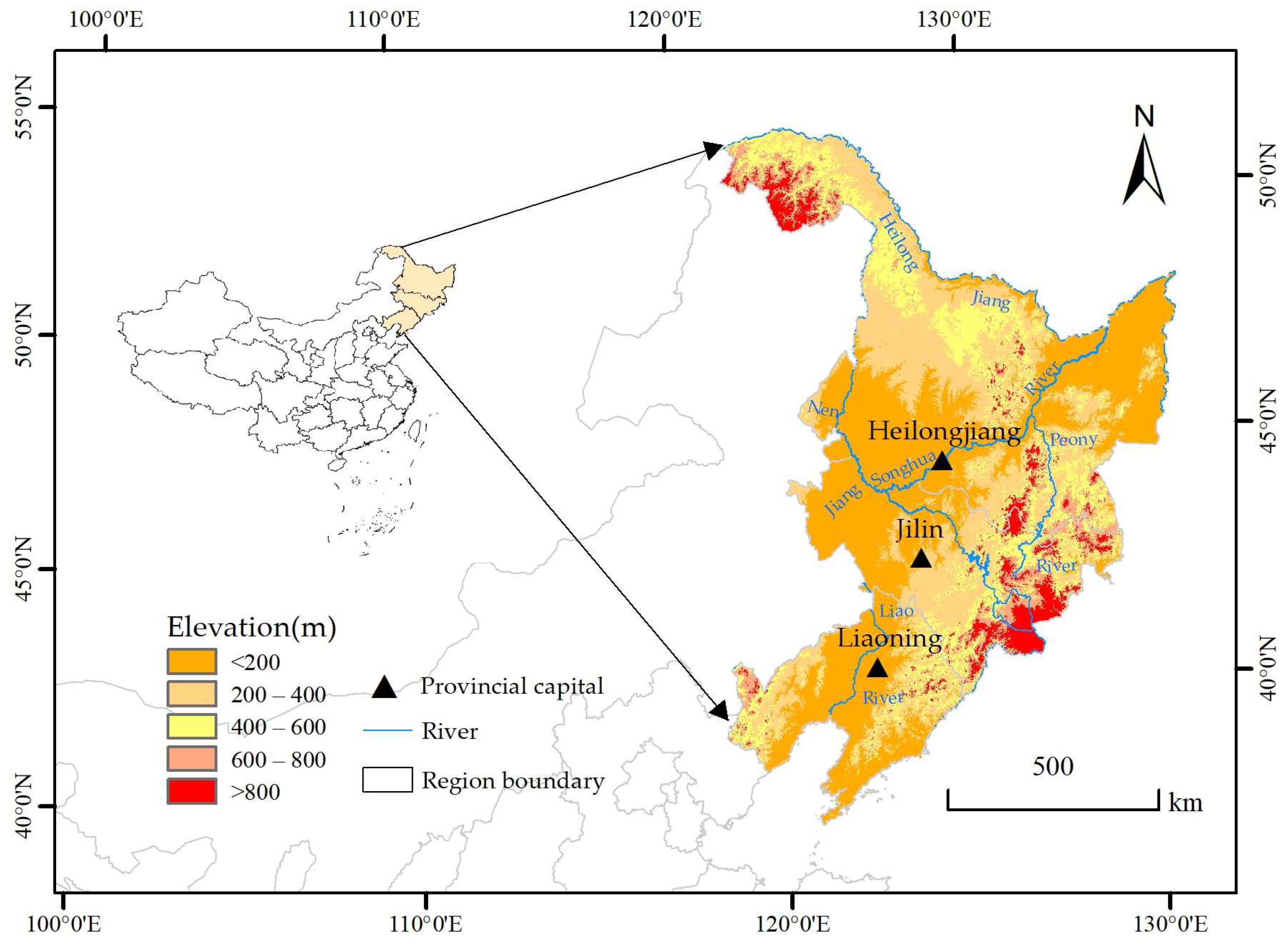
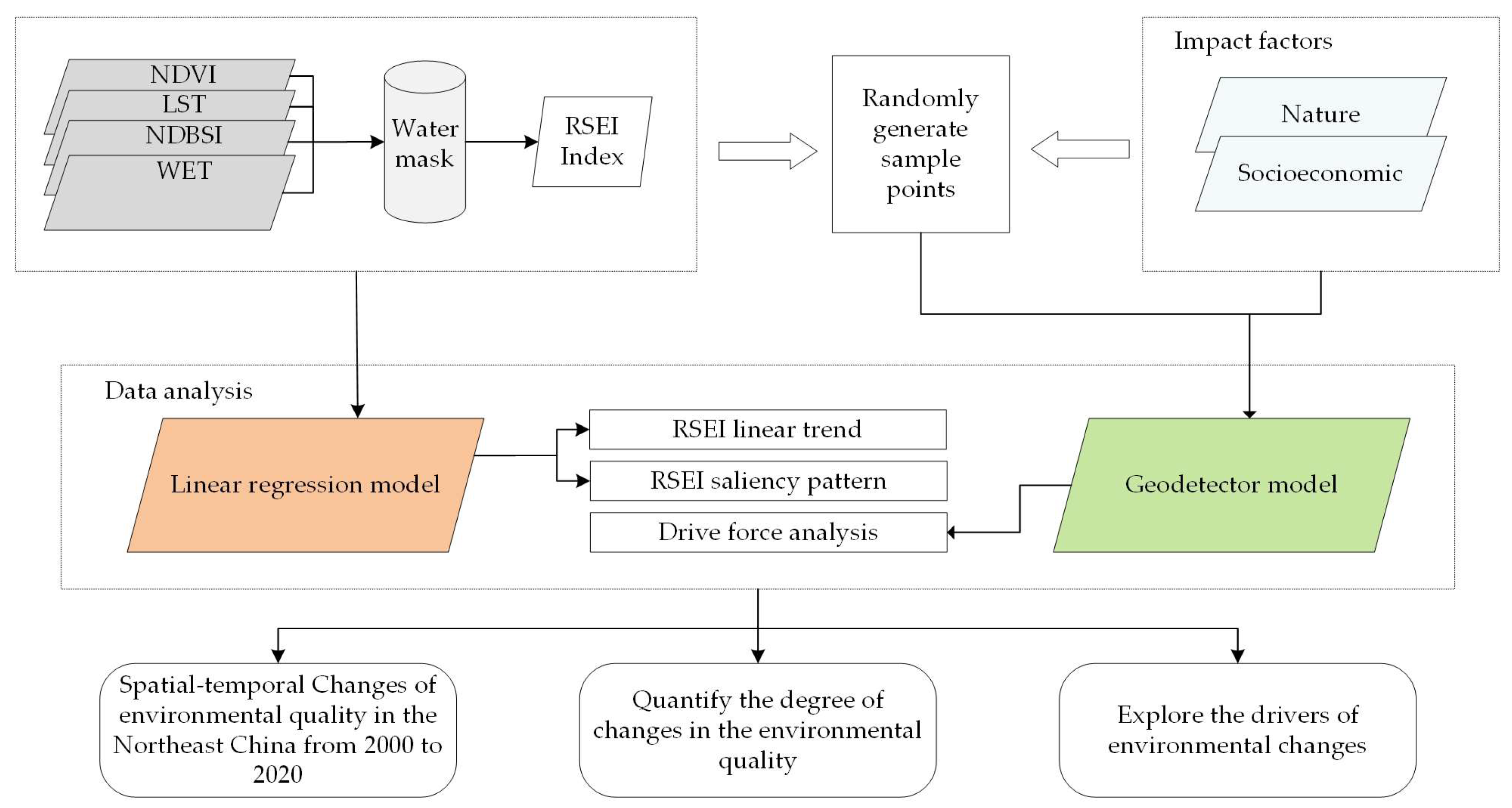
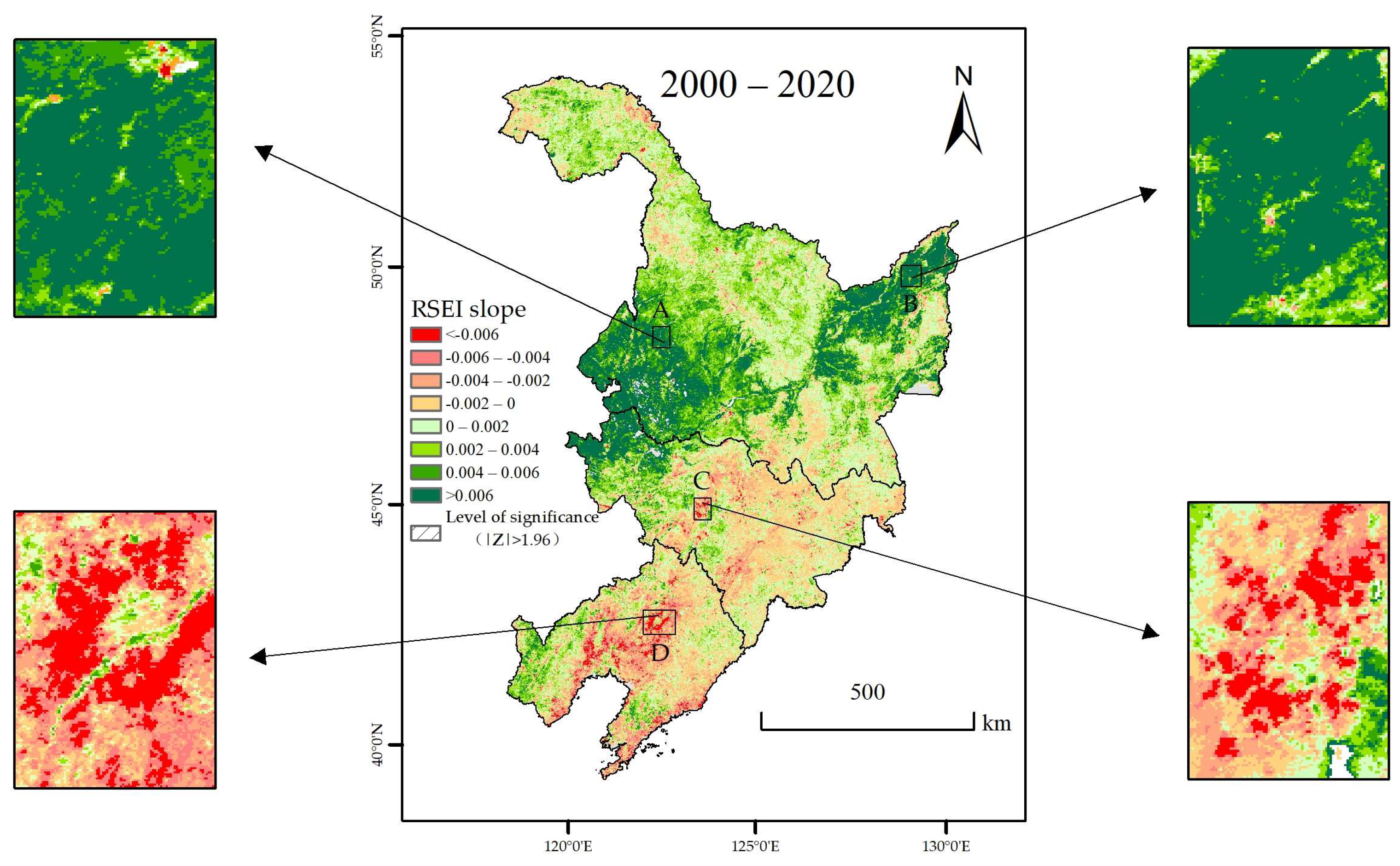
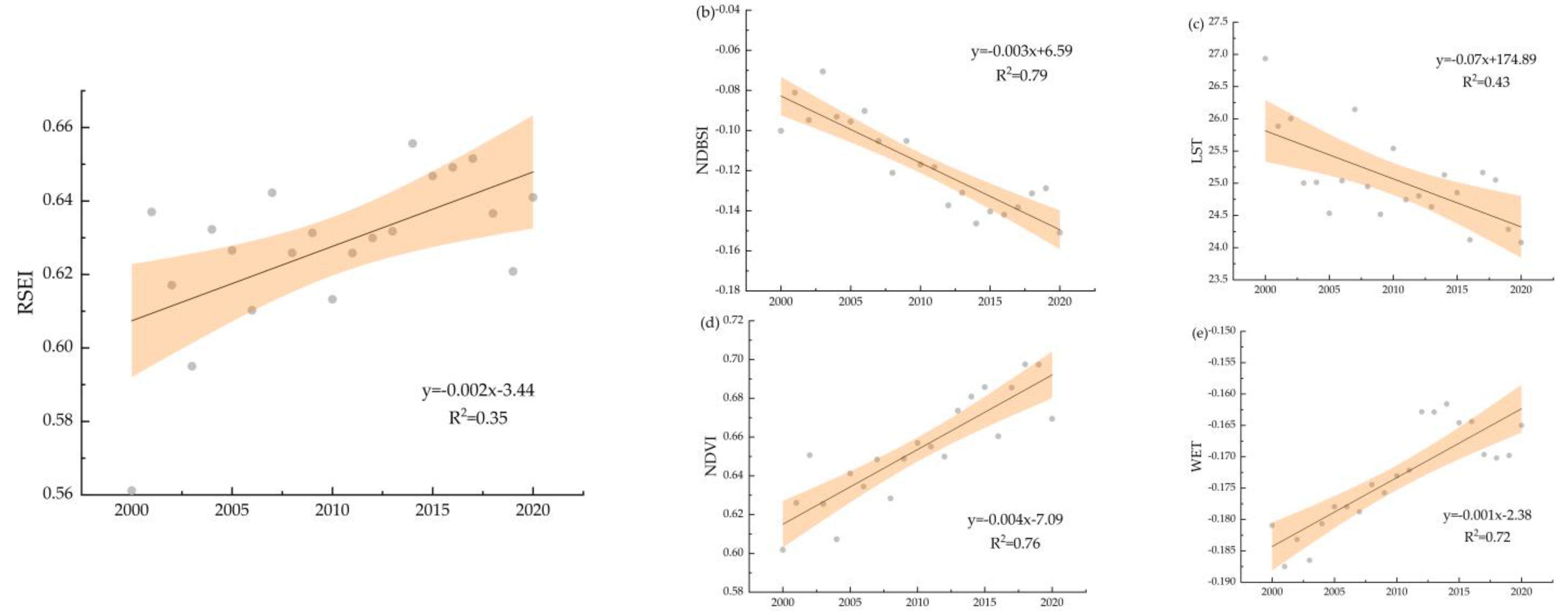

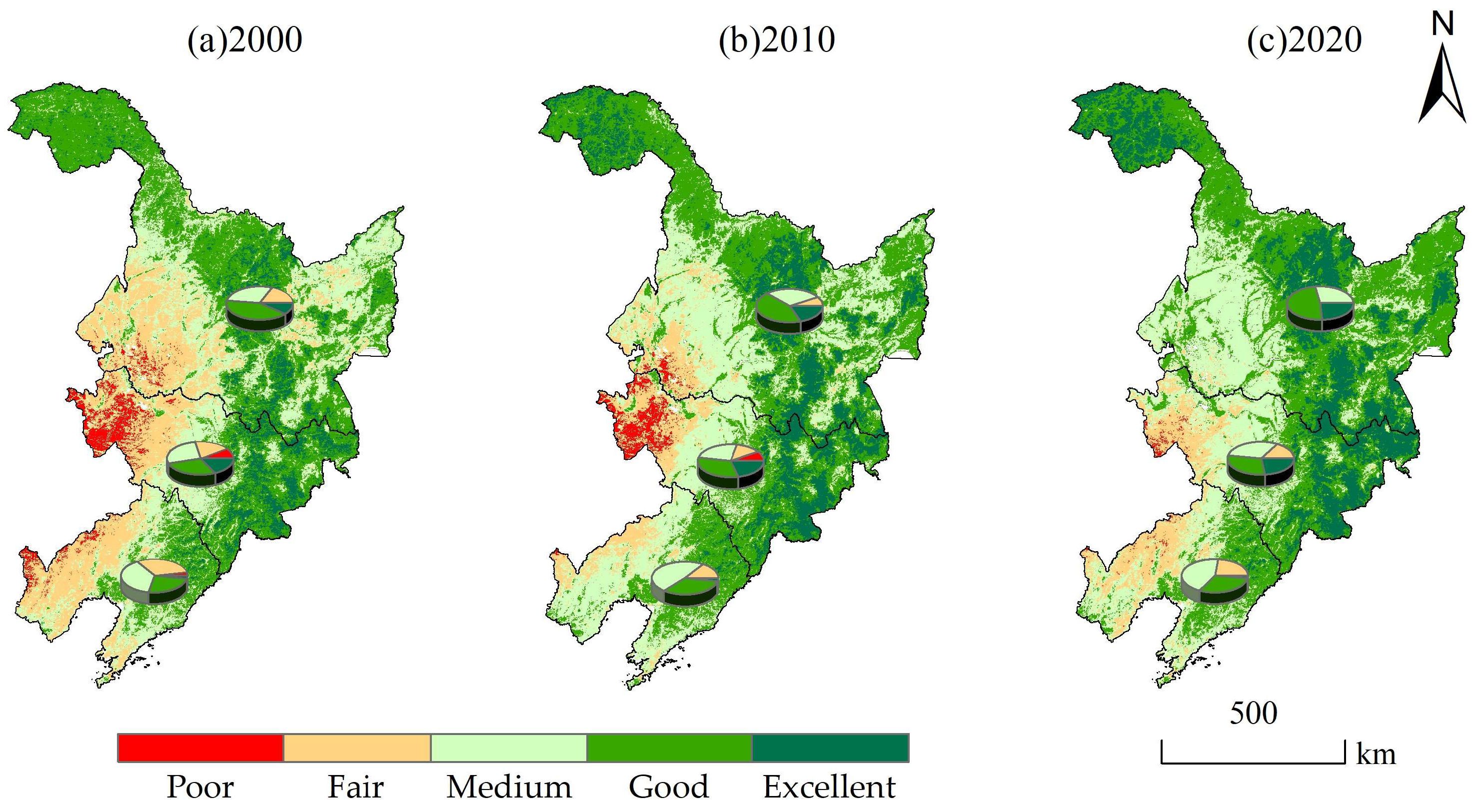

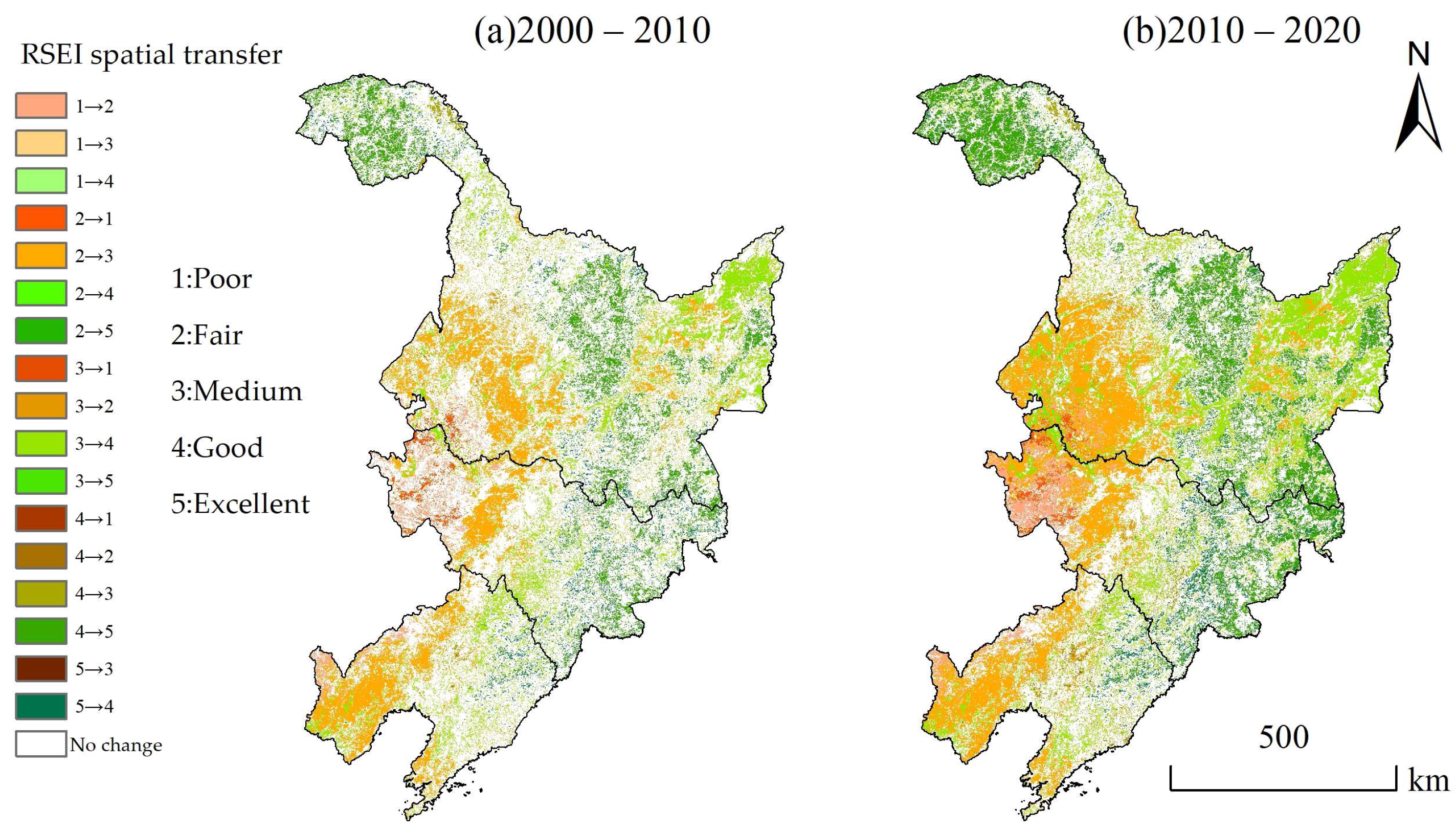
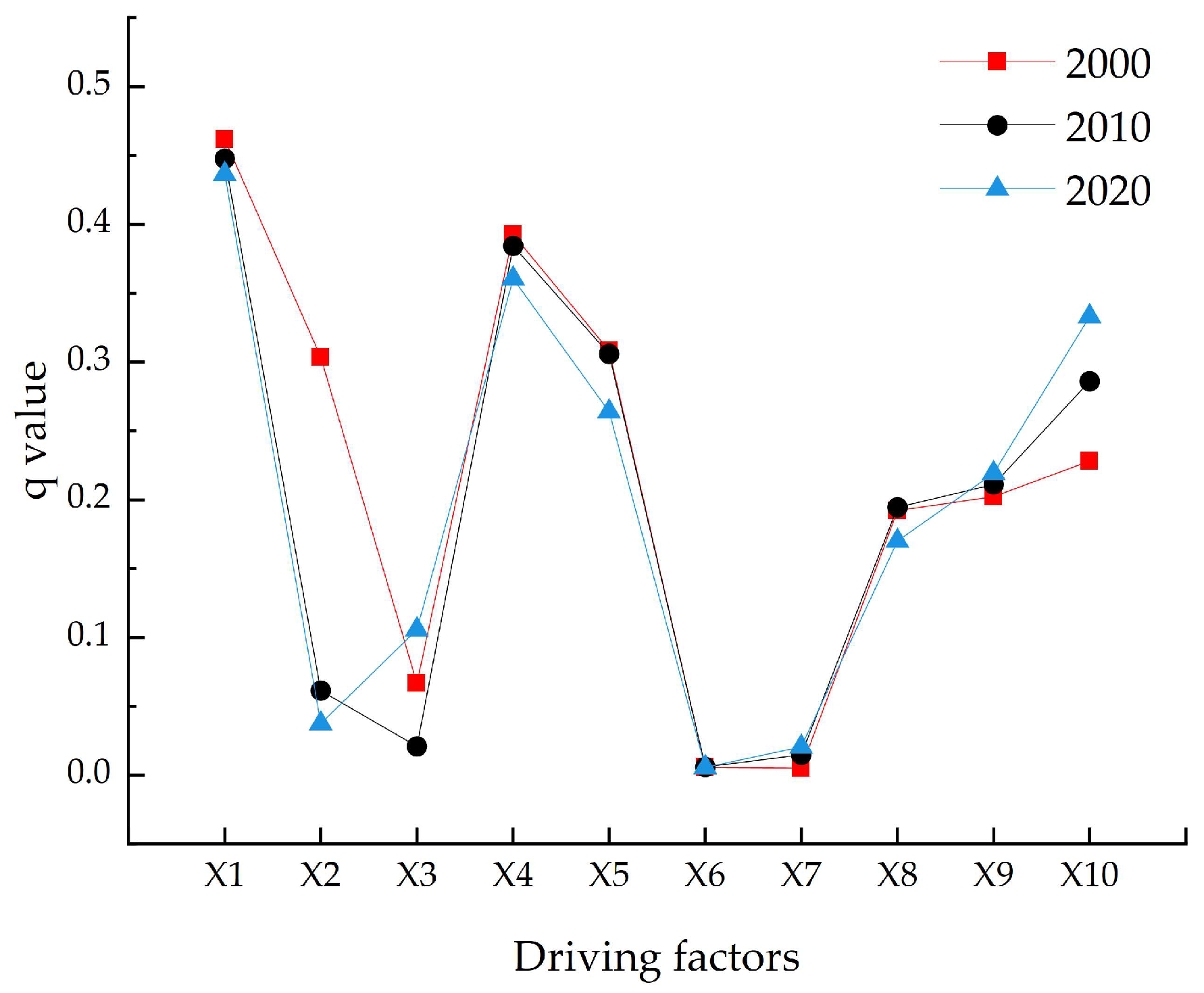

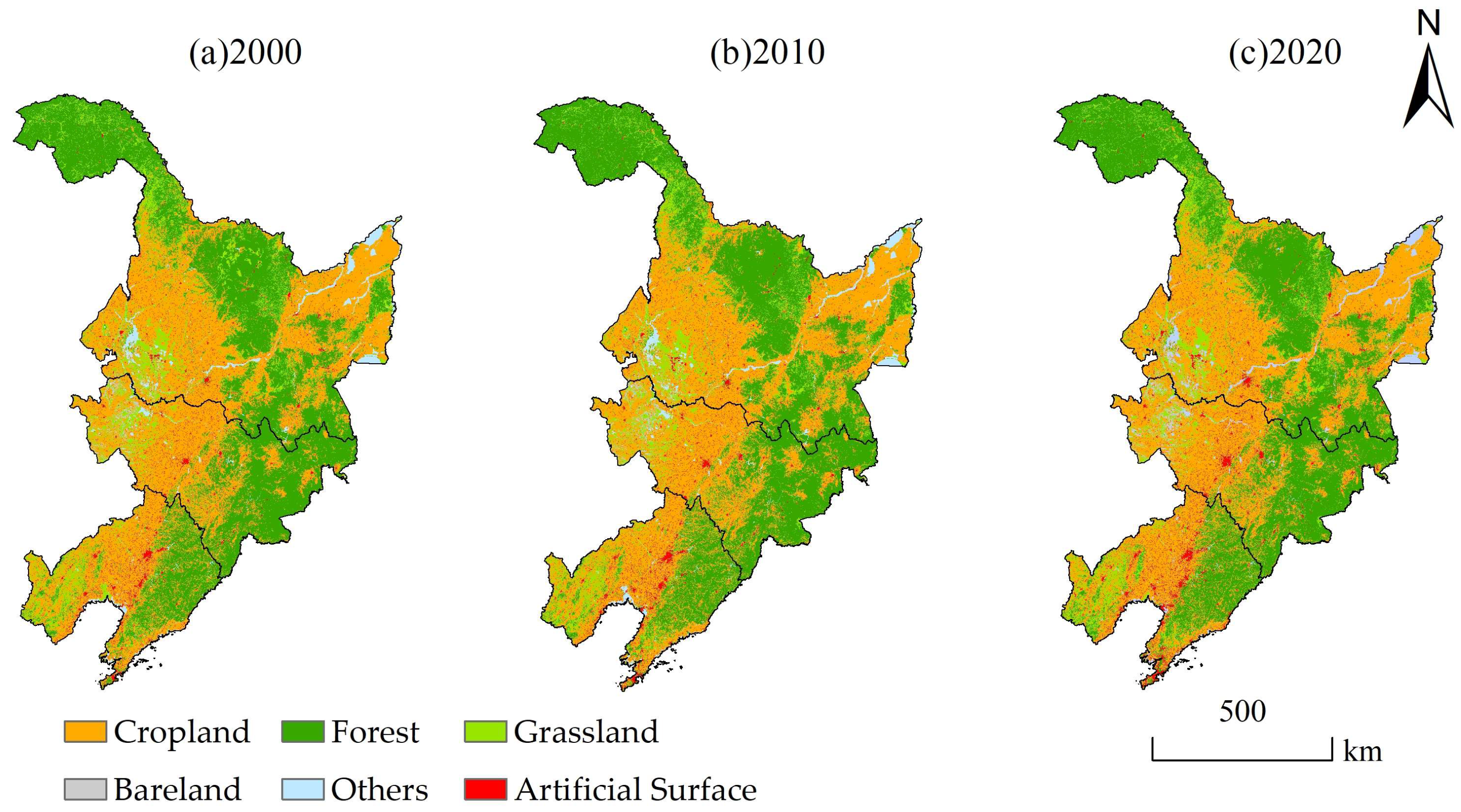
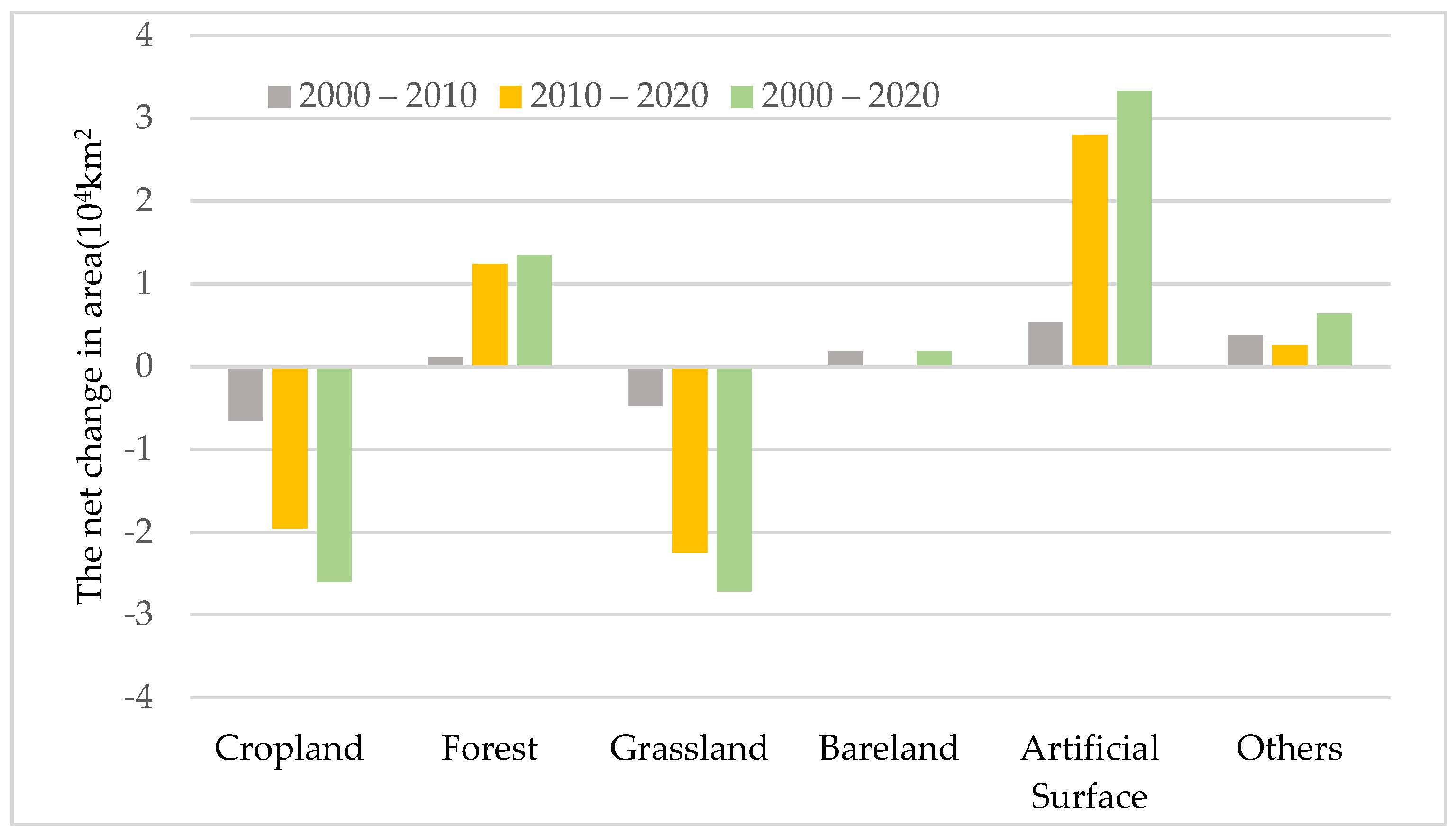
| Index | Product Name | Resolution | Source |
|---|---|---|---|
| Land-use types | Globeland30 | 30 m | https://globeland30.org (accessed on 8 January 2022) |
| Precipitation | NCEP | 1000 m | https://www.nco.ncep.noaa.gov (accessed on 11 June 2022) |
| Temperature | GLDAS | 1000 m | https://ldas.gsfc.nasa.gov (accessed on 11 June 2022) |
| Population density | GPWv4.11 | 1000 m | https://sedac.ciesin.columbia.edu (accessed on 11 June 2022) |
| Socioeconomic | GDP; total social consumption production; gross output value of farming, forestry, animal husbandry and fishery | https://tjj.jl.gov.cn (accessed on 13 July 2022) https://tjj.hlj.gov.cn (accessed on 13 July 2022) https://tjj.ln.gov.cn (accessed on 13 July 2022) |
| Indicators | Calculation Methods | Explanation |
|---|---|---|
| NDVI [19] | represents the reflectance of NIR and red bands, respectively | |
| LST [20] | DN represents the gray value of land surface temperature | |
| NDBSI [21,22] | ,,,, and correspond to the reflectance of SWIR1, red, NIR, blue, and green bands, respectively | |
| WET [23] | ,,,,,, and correspond to the reflectance of the reflectance of the red, NIR1, blue, green, NIR2, short-wavelength infrared 1 (SWIR1), and SWIR2 bands, respectively |
| Factor Types | Driving Factors | Factor Symbols | Unit | Type Numbers |
|---|---|---|---|---|
| Natural factors | Land-use types | X1 | - | 6 |
| Precipitation | X2 | mm | 7 | |
| Temperature | X3 | °C | 7 | |
| Elevation | X4 | m | 7 | |
| Slope | X5 | ° | 7 | |
| Aspect | X6 | ° | 9 | |
| Socioeconomic factors | Population density | X7 | People\km² | 9 |
| GDP | X8 | Billion | 9 | |
| Total social consumption and retail sales | X9 | Billion | 9 | |
| Gross output value of farming, forestry, animal husbandry and fishery | X10 | Billion | 9 |
| Year | Indicators | PC1 | PC2 | PC3 | PC4 |
|---|---|---|---|---|---|
| 2000 | NDVI | 0.5174 | 0.7085 | −0.0629 | −0.4756 |
| LST | −0.5661 | 0.2668 | −0.7711 | −0.1164 | |
| NDBSI | −0.5508 | 0.001 | 0.505 | −0.6644 | |
| WET | 0.3291 | −0.6532 | −0.3823 | −0.5645 | |
| Eigenvalue | 0.0546 | 0.0054 | 0.0039 | 0.001 | |
| Percent Eigenvalue/% | 84.00 | 8.34 | 6.04 | 1.63 | |
| 2010 | NDVI | 0.5309 | 0.6949 | −0.2655 | 0.4058 |
| LST | −0.5945 | 0.1243 | −0.793 | 0.046 | |
| NDBSI | −0.4355 | −0.0026 | 0.3737 | 0.8188 | |
| WET | 0.4181 | −0.7082 | −0.4011 | 0.4032 | |
| Eigenvalue | 0.04 | 0.0062 | 0.0027 | 0.0005 | |
| Percent Eigenvalue/% | 80.83 | 12.59 | 5.45 | 1.13 | |
| 2020 | NDVI | 0.5072 | −0.7054 | −0.4937 | 0.0368 |
| LST | −0.7234 | −0.0374 | −0.6892 | 0.0062 | |
| NDBSI | −0.0293 | 0.0033 | 0.0396 | 0.9987 | |
| WET | 0.4673 | 0.7078 | −0.5287 | 0.0323 | |
| Eigenvalue | 0.0261 | 0.0071 | 0.0034 | 0 | |
| Percent Eigenvalue/% | 71.32 | 19.4 | 9.27 | 0.01 |
| 2000–2020 | C | D | ||||||||
|---|---|---|---|---|---|---|---|---|---|---|
| Cropland | Forest | Grassland | Artificial Surface | Others | Cropland | Forest | Grassland | Artificial Surface | Others | |
| Cropland | 2494.25 | 59 | 15 | 677.5 | 20 | 3960 | 253.5 | 142.5 | 642.5 | 96.75 |
| Forest | 58.5 | 110 | 12.25 | 18.75 | 4.5 | 241.5 | 837 | 111.25 | 23 | 7.25 |
| Grassland | 14.75 | 7.25 | 3.25 | 7.5 | 0.5 | 136.5 | 100.25 | 94.5 | 44 | 5.25 |
| Artificial surface | 193.75 | 12.5 | 1.75 | 337.5 | 2 | 388.75 | 24.25 | 27.5 | 841.5 | 29 |
| Others | 7.25 | 4 | 0 | 4 | 52.25 | 55 | 9 | 4.75 | 14 | 60.75 |
Publisher’s Note: MDPI stays neutral with regard to jurisdictional claims in published maps and institutional affiliations. |
© 2022 by the authors. Licensee MDPI, Basel, Switzerland. This article is an open access article distributed under the terms and conditions of the Creative Commons Attribution (CC BY) license (https://creativecommons.org/licenses/by/4.0/).
Share and Cite
Gong, E.; Shi, F.; Wang, Z.; Hu, Q.; Zhang, J.; Hai, H. Evaluating Environmental Quality and Its Driving Force in Northeastern China Using the Remote Sensing Ecological Index. Sustainability 2022, 14, 16304. https://doi.org/10.3390/su142316304
Gong E, Shi F, Wang Z, Hu Q, Zhang J, Hai H. Evaluating Environmental Quality and Its Driving Force in Northeastern China Using the Remote Sensing Ecological Index. Sustainability. 2022; 14(23):16304. https://doi.org/10.3390/su142316304
Chicago/Turabian StyleGong, Enjun, Fangxin Shi, Zhihui Wang, Qingfeng Hu, Jing Zhang, and Hongxin Hai. 2022. "Evaluating Environmental Quality and Its Driving Force in Northeastern China Using the Remote Sensing Ecological Index" Sustainability 14, no. 23: 16304. https://doi.org/10.3390/su142316304






